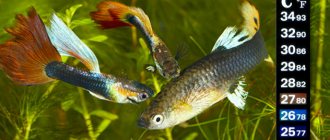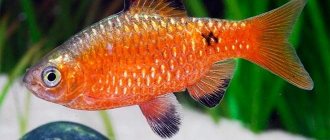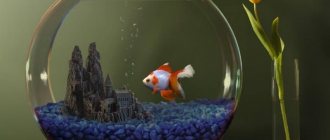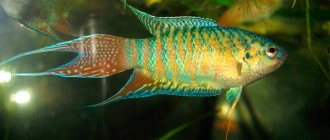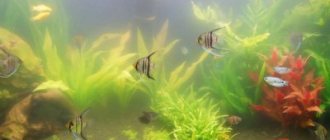Changeling catfish (Synodontis nigriventris) are often not noticed in pet stores, they hide in shelters or are invisible in large aquariums among large fish.
However, they are charming fish and will make a wonderful addition to some types of aquariums.
Synodontis is a species of the family (Mochokidae), better known as naked catfish, due to the lack of the traditional hard scales of catfish.
Synodontis have fairly strong and spiny dorsal and pectoral fins, and three pairs of whiskers, which they use to search for food in the ground and study the surrounding world.
History and description
Catfish synodontis belongs to the family of mottled catfish. Its natural habitat is freshwater bodies of Cameroon and the Republic of Congo. Most catfish are found in the African rivers Lekini and Malebo. They are also often found in wetlands.
This fish received the Latin name “synodontis” due to the specific structure of its jaws. Their teeth merged into a single plate. Actually, the word “synodontis” means “fused teeth”.
Cirrus catfish were brought to Europe in the 50s of the 20th century. They immediately fell in love with aquarium fish lovers for their small size and good compatibility with other aquarium inhabitants.
The appearance of catfish can vary significantly, but they all have common features:
- The body of variegated synodontis is elongated and laterally flattened. The back is slightly arched.
- The fish's eyes are large and located on the sides of the skull.
- The mouth is large, located deep below the head and framed by a thick lip. In the immediate vicinity of it grow 3 pairs of whiskers. This is an auxiliary tool that makes it easier for fish to navigate in the darkness of a night reservoir.
- Aquarium synodontis fish have different colors. It all depends on the specific species. Common to all are bright colored spots on the skin.
- All catfish have very similar fins. The dorsal has a triangular shape with a spiny edge. The pectoral fins are large and elongated. The tail has an elongated V-shape.
All catfish have an excellent appetite. Insects, snails, vegetation and even small fish are all eaten by synodontis.
Synodontis is a schooling and peaceful fish that becomes active in the late afternoon. During the day, she practically does not go out into open areas and hides somewhere in shelters.
Description
Synodontis are active in the evening and at night. In daylight, fish rest in shelter. They are in an inverted position almost all the time, turning their back up only when eating.
Due to the unique method of swimming, the external characteristics are specific: the back is lighter than the belly. The description is as follows:
- The body is dark gray, covered with brown spots;
- Length 9 cm;
- The physique is slim.
Representatives of the species are devoid of scales. The skin is thick and covered with protective mucus. The pectoral and dorsal fins are developed and equipped with spiny hooks. The caudal fin is clearly divided into two parts. An adipose fin is visible near the tail.
Habitat in nature
The homeland and only home of the polyspotted synodontis is Lake Tanganyika, which is located in four countries: Tanzania, Burundi, DR Congo and Zambia. The cuckoo catfish is endemic to this reservoir, so it is impossible to find it in other lakes.
Here the fish live at a depth of about 30 - 40 meters, where a small amount of sunlight reaches and where the composition of the water practically does not change over time. Animals prefer places with little vegetation, where sandy soil alternates with stone.
Aquarium volume
Since the average body length of a cuckoo catfish is approximately 13 cm, an aquarium should be selected with a volume of at least 100 liters to accommodate 3-4 individuals. Filtration should be effective, but not too powerful. Aeration is required.
Water parameters
For polyspotted synodontis, the following water parameters will be comfortable:
- Acidity – 6.8 – 7.8 pH;
- Hardness – 20 – 30°;
- Temperature – 25 – 28°С.
Lighting
Lighting should be diffused and dim. This is due to the fact that in their natural habitat, fish are predominantly nocturnal, and therefore they will hide in shelters from too bright light. A good option would be to use low power lamps or place the aquarium in a room that is located on the shady side of the apartment or house.
Frequency of water changes
Catfish - cuckoos are demanding on water quality. Therefore, it must be replaced strictly every week, updating 30% of the total volume.
Priming
Sand or fine gravel works well as soil for an aquarium. Before placing it in a reservoir, it should be thoroughly washed, disinfected and laid on the bottom in a layer 5–7 cm thick.
Plants and decor
In natural habitats, catfish practically do not encounter plants and are absolutely indifferent to them. Therefore, you should choose neutral flora as an aquarium decor:
- All types of Echinodorus;
- Cryptocoryne;
- Duckweed (will diffuse lighting);
- Anubias;
- Vallisneria;
- Limnobium;
- Hornwort.
Since polyspotted synodontis are nocturnal animals, the presence of shelters is extremely important for these fish. Therefore, in the aquarium it is necessary to place through grottoes, caves, houses, snags and pots in such quantities that each individual has enough of them.
Living conditions for shifters
Housing for a catfish shifter must be selected taking into account its size.
Individuals with a 10-centimeter body require an aquarium of at least 50 liters. If the fish reaches 13-15 cm, give it space of 80 levs. If your synodontis has grown to 20-25 cm, increase the water volume to 150 liters.
The parameters of the liquid in the aquarium are as follows: acidity (pH) about 7-8, temperature - 24-26 degrees Celsius, hardness - 10-15 degrees hardness.
We recommend reading
About the reproduction of Ancistrus catfish
The skinwalker will be happy if you cover the bottom with small pebbles about 5 mm in diameter. The soil, washed without the use of detergents and treated with boiling water, is poured in a layer of approximately 7 cm.
Plant vegetation in pots. This way the catfish will not damage their roots. Stemless Echinodorus, Anubias and heat-loving Cryptocoryne are best suited.
Catfish will feel comfortable in the company of 4-6 individuals.
Characteristics of varieties
Scientists know more than 150 species of these fish. Moreover, not all of them are described. Only a few are the most popular among aquarists.
Catfish cuckoo
Its Latin name is synodontis multipuctatus , which means multi-spotted synodontis. This catfish is very popular among aquarium owners who breed Tanganyika cichlids.
Synodontis like to hide in cover.
This fish is called cuckoo because during the breeding season it quickly swims past spawning cichlids and throws its own eggs into their clutches. The Labidochromis female takes them for her own and hides them in her mouth during the entire incubation period.
The skin of synodontis multipunctatus is light with a yellowish tint. There are dark spots of different configurations and sizes throughout the entire body area. In aquarium breeding conditions, the fish can grow up to 12 cm in length. Males are easy to distinguish from females. They are slimmer and have brighter colors. It is not difficult to keep Synodontis multispotted. You need to give them an aquarium with a volume of at least 80 liters. Inside it there should be various shelters: artificial grottoes, caves and snags.
To prevent catfish from damaging their delicate antennae in the aquarium soil, there should be no sharp elements. Therefore, when creating a substrate, it is better to use coarse river sand, small pebbles and gravel without pronounced corners.
Water parameters:
- it must have a neutral acid-base balance;
- hardness within 15−20 °F;
- temperature ranges from 23 to 28 °C;
- high level of aeration and filtration.
To maintain the health of pets, the aquarist will have to completely change at least one fourth of the total volume of water in the aquarium at least once a week.
Who do catfish catfish and other synodontis live with?
Synodontis are large in size, and therefore get along well with predatory fish species. Changelings get along well with comparable species , but they are very voracious and therefore dangerous for small fish. The walrus catfish is quite peaceful, but with age it can become aggressive towards members of its own species. Eupterus is one of the few species that are compatible with African cichlids. Veiled synodontis are capable of showing aggression towards other bottom-dwelling fish, so it is better to house them with species that live in the middle and upper layers of water. Petrichola catfish boasts good compatibility with other fish. It can be considered the best choice for adding to an aquarium inhabited by fish of different sizes.
Synodontis have an unpleasant habit of eating the wounds of other fish. Moreover, they gnaw away the damage right to the bones. Therefore, it is important to promptly remove injured neighbors from the common aquarium. You should not return the fish to the community aquarium until the damage has completely healed.
Thus, synodontis catfish are unpretentious in keeping and not picky in feeding. These fish serve as aquarium orderlies: they clean the walls and soil of organic residues. They are peaceful, but have a good appetite, and therefore can easily eat small fish. Since most species of synodontis grow to considerable sizes, the fish need large, spacious aquariums with good aeration.
Content
Synodontis are unpretentious creatures to keep. However, it is necessary to take into account that in their natural environment they live in transparent and clean bodies of water, so at home they should select water with the appropriate parameters:
- neutral pH – 6.5-7.5;
- temperature - +24...+26 °C;
- water hardness - 4-15°.
The catfish, a photo of which you can see below, needs additional filtration and aeration of the water. In addition, it is necessary to carry out a 30% water change once a week.
Feeding
The cuckoo catfish is considered not only an omnivorous fish, but also an aquarium cleaner. He happily eats algae from the walls of the aquarium, worms, snails and, in some cases, even carrion.
For the full development of fish and further maintenance of its health, the animal’s diet should consist of 70% protein foods:
- Worms;
- Koretra;
- Insects.
The rest of the menu is occupied by plant and dry food.
Dry food should only be purchased at pet stores. They must be designed specifically for catfish. The serving size and its composition are indicated on the packaging.
Multispotted synodontis are prone to overeating, and, as a result, obesity. You need to feed the fish once a day in the late afternoon (1 - 2 hours before the end of daylight). The serving size is determined by the amount that the flock can eat in 4 - 5 minutes. Next, the remaining food is caught and removed.
Nutrition and reproduction
Synodontis catfish feeds on literally everything. But this doesn't mean you can feed your pets randomly. Bring the ratio of live food and the rest of the diet to 70% to 30%.
The main part of the menu includes shrimp, tubifex, bloodworm, coretra, cod fillet and even thinly sliced meat pieces. Plant foods are also necessary. The catfish is happy with oatmeal, cucumbers or zucchini, dandelion leaves and bread crumbs.
Small aquarium inhabitants may be interested in Synodontis as prey. If a fish swims close to a hungry catfish, it will eat it. Therefore, always place the fry on time.
Reproduction of synodontis in captivity is possible only after hormonal stimulation. Compatible with cockerels, danios, gourami, guppies. It is not recommended to keep koi and piranhas together.
We recommend reading
Japanese koi carp
Reproduction
There is not much information available about the breeding of Synodontis and some are disputed by scientists.
In the wild, individuals migrate to spawn during the rainy season. Therefore, some aquarists advise cooling the water a few degrees to approach spawning time.
Females lay their eggs in holes or depressions that they find in advance. The female is capable of laying about 400 eggs.
After 5 days, catfish fry hatch from the eggs. At a young age they usually swim. But after 6 weeks they become like adult fish and turn over in the water. The fry feed on brine shrimp and small worms.
Sex differences
You can distinguish a female from a male by several characteristics:
- By the time she reaches sexual maturity, the female becomes plumper.
- The male's dorsal fin is sharper.
- The genital nipples of females are more rounded than those of males.
Changeling catfish: reproduction
Synodontis reaches sexual maturity by 2-3 years. To create conditions for spawning, you need to acquire a 50 liter aquarium and equip it as we described earlier. Water must have the following characteristics:
- pH – 7;
- rigidity - 10°;
- temperature - +27 °C.
Owners of these fish should be aware that they reproduce extremely rarely in aquariums, so hormonal injections must be used to stimulate spawning. First, isolate the female from the male, providing the fish with an intensive diet containing at least thirty percent plant food.
During spawning, the male pursues his chosen one, swimming behind her upside down, at some point the fish stop for a moment, and caviar appears in the water. Its size does not exceed two millimeters. It has a light yellow color. The female lays about a thousand eggs at a time, which are washed away by the water flow. In this regard, after spawning is completed, it is necessary to stop the flow in the aquarium and remove the producers.
Diseases
Changelings are hardy fish with strong immunity. Most diseases bypass them. Immune to diseases that affect other species from the tropics.
Possible diseases:
- Obesity. Catfish tolerate hunger well and can go without food for several days without any problems. But overfeeding is dangerous. Especially food of animal origin. To return the body to normal, it is necessary to reduce the amount of food and arrange days without food once or twice a week to maintain tone.
- Stress. A symptom of stress is a pale, dull body color. Causes of stress: overcrowding of the aquarium, aggressive neighbors, lack of food. Observe the changeling and determine the cause of the stressful condition. Only then begin treatment.
- Oxygen starvation. It is easy to detect a lack of oxygen - the fish are lethargic, inactive, often open their mouths, and swim sideways. The cause of oxygen starvation is a breakdown of the aeration device. Hydrogen peroxide is added to quickly increase the oxygen level in the water.
- Fin rot. Bacteria live at the bottom of the aquarium. When a fish is weakened or sick, it lies on the bottom for a long time. This will lead to the appearance of putrefactive formations on the body. Treated with a streptocide bath.

